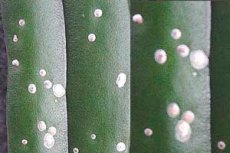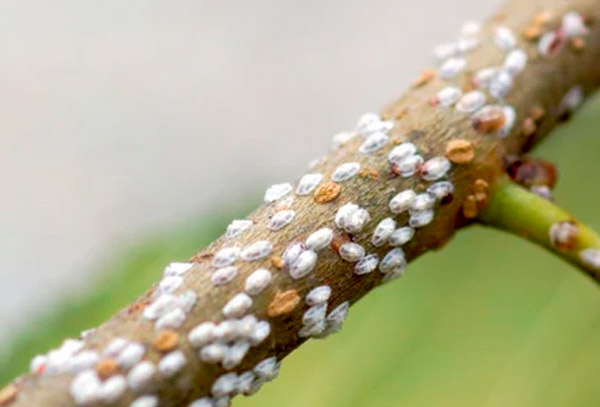Scale insects on orchids
Last reviewed: 11.03.2025

Scale insects on orchids are one of the most common and harmful pests that can seriously damage the plant if not addressed promptly. In this article, we will discuss how to recognize scale insects on orchids, the symptoms indicating their presence, and effective methods for controlling them.
What are scale insects and what do they look like?
Scale insects are small pests with a hard protective shell, which shields their body. There are different types of scale insects, but on orchids, the most common are coccids, also known as "scale bugs." these insects resemble small bumps on the leaves and stems of the plant, which can be brown, yellow, or gray, depending on the species.
If you closely examine an orchid, you may notice small round or oval growths on the leaves or stems, which are the protective shields of the female scale insect, hiding its body and eggs. Under this shield, larvae feed on the plant’s sap.
Photos of scale insects on orchids typically show brown or yellowish bumps on the leaves and stems. If a large number of scale insects are present on the plant, the leaves will begin to yellow, dry out, and develop spots.

Life cycle of scale insects on orchids
1. Egg stage
Scale insects lay eggs under their shells or on the underside of orchid leaves. A single female can lay several dozen eggs.
- Duration: 1–3 weeks (depending on temperature and humidity).
2. Larva stage ("crawlers")
The larvae emerge from the eggs and begin moving actively across the plant in search of a suitable place to settle. During this stage, they are most vulnerable and can be treated with insecticides.
- Duration: 1–2 weeks.
3. Nymph stage
The larvae attach themselves to the plant, lose mobility, and begin to form a protective shell. During this time, they feed on the plant’s sap, weakening it.
- Duration: 2–4 weeks.
4. Adult stage
Adult scale insects are completely immobile and have a hard shell that protects them from external factors. Females continue feeding on the orchid’s sap and lay new eggs, perpetuating the life cycle.
- Lifespan: 2–6 months (depending on environmental conditions).
How do scale insects damage orchids?
Scale insects feed on the sap of orchids, damaging their cells. A severe infestation can weaken the plant's immune system, leading to poor health and even the death of the orchid. The main signs of scale insect infestation include:
- Yellowing leaves — orchid leaves begin to yellow, which can indicate damage from sap extraction.
- Brown or yellow growths — these are the shields of scale insects, under which pests reside.
- Sticky residue — scale insects secrete a waxy substance that can coat the leaves of the orchid. This residue provides a breeding ground for sooty mold.
- Stunted growth — an orchid affected by scale insects will not grow as vigorously as a healthy plant and may even stop flowering.
- Spots on leaves — if scale insects are left untreated for a long time, the leaves may develop spots as a result of tissue damage.

How to get rid of scale insects on orchids?
If you notice scale insects on your orchids, it's important to take action quickly to prevent further damage. Here are several methods to control these pests:
- 1. Mechanical removal of scale insects
The first and simplest method is to physically remove scale insects from the plant. You can use a soft brush or a cotton pad soaked in alcohol (such as medical or ethyl alcohol). Gently wipe the leaves and stems of the orchid, carefully removing the visible scale shields.
This method is effective if the infestation is not too severe. However, if there are many scale insects, this method alone may not be sufficient.
- 2. Alcohol solution treatment
After mechanically removing the visible scale insects, you can treat the orchid with an alcohol solution to kill any remaining larvae and eggs. Mix 70% alcohol with water (1:1 ratio) and apply the solution to all parts of the plant, including stems and leaves. This will kill the scale insect larvae and help reduce the infestation.
- 3. Using insecticides
For more severe infestations, you may need to use insecticides. Many insecticides designed for scale insects contain pyrethroids or other active ingredients that are effective against various pests. Some examples of such products include:
- Aktara
- Confidor
- Fitoverm
Before using insecticides, it’s important to carefully read the instructions to avoid damaging the plant.
- 4. Soap solution treatment
A popular home remedy for scale insects is using a soap solution. To prepare it, dissolve household soap in water. This solution helps remove scale insects from the plant’s surface and kills any eggs and larvae hiding under the shield.
- 5. Repotting the orchid
If scale insects have severely damaged the roots or soil, it’s advisable to repot the orchid in fresh, sterile soil. During the repotting process, carefully inspect the roots, remove any damaged sections, and rinse them in a fungicide solution to prevent re-infestation.
- 6. Preventing scale insects in the future
To prevent scale insects from infesting your orchids again, it’s essential to regularly inspect your plants for pests. Additionally, ensure proper care by following these guidelines:
- Avoid overwatering — scale insects often target weakened plants that suffer from improper watering.
- Remove old leaves — leaves that start to wilt or die are ideal hiding places for pests.
- Ventilate the room — lack of airflow can lead to excessive humidity and increase the risk of pest infestations.
Conclusion
Scale insects on orchids are a serious pest that can negatively affect the plant’s health. Early detection and timely intervention are crucial to preventing significant damage. Mechanical removal, the use of insecticides and soap solutions, and regular plant care will help eliminate scale insects and keep your orchids healthy.
